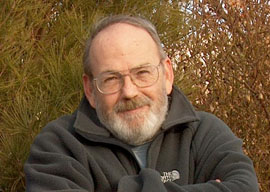
April 06, 2016

Henry Harpending
Source: Courtesy of Utah Edu
In 2005, they illustrated their general thesis with a stunning paper on “The Natural History of Ashkenazi Intelligence.” One of the great scientific papers of the age, it elicited admiring attention from Steven Pinker and Nicholas Wade. Henry and Greg noted that the proliferation of European Jewish genetic diseases such as Tay-Sachs and torsion dystonia are likely offshoots of selection pressure for literacy and numeracy in white-collar occupations in medieval Europe. Just as black Africans are more prone to sickle-cell anemia because it’s a quick and dirty malaria-fighting mutation, European Jews may have evolved IQ-boosting mutations that extract a medical price.
Harpending and Cochran followed with a mass-market book, The 10,000 Year Explosion: How Civilization Accelerated Human Evolution, which featured their prediction that modern humans would have some DNA descended from the otherwise extinct Neanderthal species. This was soon confirmed, although to their surprise it turned out that sub-Saharan Africans lacked whatever useful genes the rest of humanity had acquired from Neanderthals.
In 2013, Harpending and Cochran drafted a paper on how the Amish have been evolving over the ten generations they”ve been in America toward “plainness.” While it was formerly assumed that Amish culture would collapse under the blandishments of American consumer society, the opposite appears to be happening: The rate of Amish young adults abandoning their arduous faith is, if anything, dropping. Harpending and Cochran calculated that the Amish have been here long enough for a significant fraction of the DNA that would incline them to join the general population to have “boiled off,” leaving a more concentrated set of genes adapting the rapidly growing remainder toward the Amish lifestyle.
One of Harpending’s most interesting mathematical solutions was calculating just how much individuals of different racial groups differ. The Leninist biologist Richard Lewontin had famously observed in the 1970s that only about 15 percent of genetic variation among humans could be attributed to racial differences.
Lewontin, however, didn”t provide the public with a scale for evaluating how large that figure is. After all, there is considerable genetic diversity even among siblings who aren”t identical twins, and yet the Arabs politically organize their cultures around the maxim: “Me against my brother, my brother and I against my cousin, my cousin and I against the world.”
Henry long dismissed the concept of ethnic nepotism, until he finally sat down to do the math in the early 2000s. Then he discovered that the similarity within racial groups was comparable to the degree of relatedness between an uncle and his nephew…which is where the word “nepotism“ comes from.
In other words, on average, people are as closely related to other members of their subracial “ethnic” group (e.g., Japanese or Italian) versus the rest of the world as they are related to their nephew versus the rest of their ethnic group.
When you stop and think about it, that sounds about right. As Henry pointed out, he”d have a hard time identifying a nephew he”d never met from a group of white children, while he”d have no problem identifying a white child in a group of nonwhite children.
Henry was as brave at defying cowardice in the classroom as at hunting Cape buffalo in Botswana.